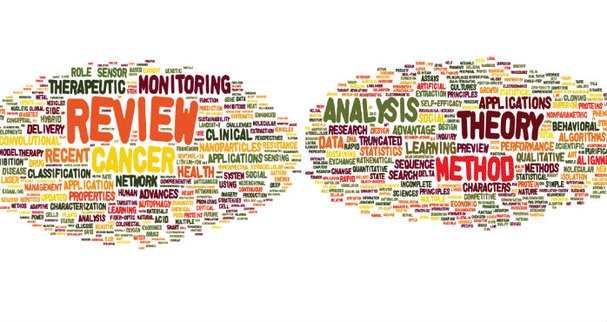
Common words in highly cited articles.
Credit: Mohamed Elgendi
5 features of a highly cited article
The difference between highly cited and lowly cited papers.
23 August 2019

Mohamed Elgendi
Common words in highly cited articles.
Understanding what makes a paper impactful is something many scientists obsess over.
I recently downloaded 200 articles from 202 open-access journals across a broad range of disciplines from the Multidisciplinary Digital Publishing Institute website (MDPI), half of which were highly cited, and the other half lowly cited.
I applied a machine learning technique called principle component analysis to the dataset to see if I could find out what a highly cited paper looks like.
Of course, correlation does not indicate causation – none of these papers are highly cited because they feature the characteristics listed below. They are most likely highly cited because of the science they contain.
Nevertheless, I hope these insights are useful.
1. A title of 7-13 words
Titles play an essential role in capturing the overall meaning of a paper. Previously published work investigating this question agrees that the title length can impact citation rates.
In addition to the 100 highly and 100 lowly cited articles mentioned above, I analyzed the top 100 articles published in Nature in 2014 (according to Google Scholar), the top 100 articles indexed by the Web of Science in 2014, and the top 100 articles in Altmetric in 2018.
The analysis revealed a consistent pattern for impactful titles: the titles of popular papers are short. Specifically, the overall length of impactful titles is ten words, give-or-take three words.
The most highly cited paper according to each database is as follows:
• MDPI: "Liposomal Formulations in Clinical Use: An Updated Review" (word count = 8)
• Google Scholar: "Cleavage of Structural Proteins During the Assembly of the Head of Bacteriophage T4" (word count = 13)
• Web of Science: "Protein Measurement with the Folin Phenol Reagent" (word count = 7)
• Altmetric: "Mortality in Puerto Rico after Hurricane Maria" (word count = 7)
2. Common words in the titles of highly cited papers
There is similarity when it comes to common words that are used in highly cited papers, which reflect the topic of interest and focus of the papers.
Below is a list the top five words in each database, ranked in descending order from left to right:
• MDPI: Review, cancer, monitoring, recent, and therapeutic.
• Google Scholar: Method, theory, analysis, applications, and learning.
• Web of Science: Method, protein, DNA, multiple, and new.
• Altmetric: Association, analysis, cancer, health, and study.

Mohamed Elgendik
3. Six authors or more
I found a correlation between the number of citations and the number of authors.
It may be that each author brings their own network to a paper, and the sum of all authors' networks will increase the number of readers who share the same research interests, which will in turn increase the likelihood of citations.
Perhaps more important is the fact that good science often requires multidisciplinarity, so the results of impactful science are likely to be attributed to more authors.
4. 35,000 characters (no spaces) at a minimum
The number of characters (without spaces) is significantly different between highly and lowly cited papers.
A highly cited paper has more than 33,600 characters, including references, (approximately 5,600 words).
5. Six figures and two tables at a minimum
Based on the results of my analysis, highly and lowly cited papers have a different approach to figures and data tables. These results suggest that highly cited articles tend to have more figures and tables.
What does it all mean?
Overall, the three most important characteristics of highly cited articles were the number of views (more is clearly better), the number of characters (more is better) and an adherence to the seven- to 13-word range in the title length.
The above, of course, does not guarantee increased citation rates. Indeed, there are more essential features that improve citation rates and overall impact, such as the journal’s reputation, the originality of the work, the importance of the topic, the authors’ fame, the journal accessibility (open access versus non-open access) and the publication type (article, review, communication).
After dealing with these factors, these tips may help to increase your readership and citation rates.
Read the full paper, published in IEEE Access.
Mohamed Elgendi is a Postdoctoral fellow at the University of British Columbia, Canada.
Read next:
Preprints boost article citations and mentions
